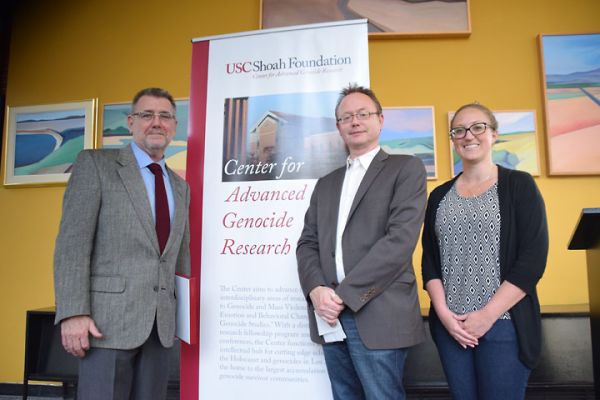Peter Hayes speaks on the different but related hatred of gays and Jews during the Nazi regime
On Tuesday, March 10, 2015, the USC Center for Advanced Genocide Research hosted a lecture from Dr. Peter Hayes who spoke before a packed room at USC on the complex relationship between anti-Semitism and homophobia exerted in Nazi-occupied territories during World War II. The Theodore Zev Weiss Holocaust Educational Foundation Professor at Northwestern University specializes in 20th-century German History, writing extensively on German industry under the Nazis. Monday's lecture, however, focused on the evolution of his views on a comparison that he was previously reluctant to address.
Is Nazi homophobia even comparable to Nazi anti-Semitism? Dr. Hayes outlined four differences between the two hatreds that had kept him from initially entertaining that question. First, the historical context for the inclusion of Jews and homosexuals in Europe took different trajectories. In short, starting from the 18th century on, European countries progressively adopted legal measures to protect Jews, making Nazi efforts to disenfranchise them a real historical reversal. On the other hand, outside of the exceptions of a variety of southern European countries that removed sodomy laws from their books as early as the 19th century, many European countries, including Germany, had a long history of outlawing gay male sexual relations. All the Nazis had to do was keep in place what was already law in Germany through Paragraph 175.
The Nazi's motives were also different. They saw Jews as parasites living among Germans, threatening Aryan purity, whereas German homosexuals were a threat by not advancing the Aryan race. Their perceived effeminacy made them undesirable for military service and they did not sexually contribute to increasing the Aryan population. The Nazi imperative to increase the Aryan population is no more evident than in Himmler's formation of the Reich Central Office for the Combating of Homosexuality and Abortion in 1936.
This leads to a third difference, the Nazi objective for each target group. For the Nazis, the problem of the Jew was an essentialist one. There was nothing that could be done to change a Jew but to remove him/her from the Body Politic (Volkskörper). This eventually entailed the Final Solution. However, the Nazis saw homosexuality as a behavioral problem, so their objective was a corrective one for German gay men. Hard labor will toughen them up.
The Nazi campaign for homogeneity was an "attack on human diversity."
Of course, the largest difference is the scale and scope of the persecutions. Whereas all Jews in Nazi-occupied territories were targeted, the Nazis were only interested in German homosexuals. They weren't interested in other nationals, unless they were of German descent or were sexually involved with Germans. Out of a population of roughly 65 million Germans, Himmler assumed that 1-2 million were homosexual men. However, the Nazis only arrested 100,000. It is estimated that 6,000 of those arrested died in concentration camps, a small percentage compared to the estimated 6 million Jews who were murdered by the Nazis; though, as Dr. Hayes points out, this is not to diminish the individual suffering of gay German men who fell victim to the Nazis.

Nevertheless, Dr. Hayes sees some similarities between the two target groups.
Nazi victory relied on military strength, reproductive fecundity, and racial purity. Both Jews and gay German men were immediate threats to the success of the Nazi state. Quoting Hannah Arendt, Dr. Hayes clarifies that the Nazi campaign for homogeneity was an "attack on human diversity" as represented by Jews and homosexuals.
The prospect of and the onset of war made Jews and gay German men simultaneous targets as well. As Dr. Hayes points out, it is not a coincidence that the apogee of both Jewish and gay male deaths occurred in the same year, 1942.
Both target groups underwent a systematic propaganda campaign of dehumanization. Not only were Jews considered less than human whose assimilation threatened the purity of the Aryan race, but homosexuals, too, were represented as pedophiles who recruited children as a means of "producing" more homosexuals, thereby keeping young Aryan men from reproducing.
Dr. Hayes also recognizes that both Jews and gay Germans who suffered under the Nazis continued to suffer long after the war. The survivors have never fully recovered from the trauma the Nazis inflicted. In fact, homosexuals imprisoned during the Nazi regime still continued to serve their sentences after the war because Paragraph 175 would not be overturned until the sixties. Yet, Nazism has effectively discredited Western anti-Semitism, which continues to be haunted by it. Not so with homophobia.